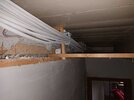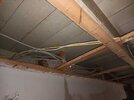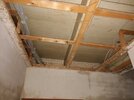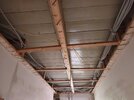We removed the light wooden slats ceiling in our hallway to reveal the substructure.
There is a beam A running the length of the hallway.
Battens B are secured adjacent to beam A.
Battens XY are then secured to the ends of battens B and a batten Z is secured to the middle of a batten B and run the length of the hallway.
Battens XY are then connected to the floorboards above the ceiling. To me this seems daft because if you try pulling up floorboards, you end up pulling on the battens and thus the ceiling.
Ideally we can remove the supports that are currently connected to the floorboards. Ideally we would plasterboard, however if a suitable substructure is not possible, we would be fine with something light such as panels.






There is a beam A running the length of the hallway.
Battens B are secured adjacent to beam A.
Battens XY are then secured to the ends of battens B and a batten Z is secured to the middle of a batten B and run the length of the hallway.
Battens XY are then connected to the floorboards above the ceiling. To me this seems daft because if you try pulling up floorboards, you end up pulling on the battens and thus the ceiling.
Ideally we can remove the supports that are currently connected to the floorboards. Ideally we would plasterboard, however if a suitable substructure is not possible, we would be fine with something light such as panels.








